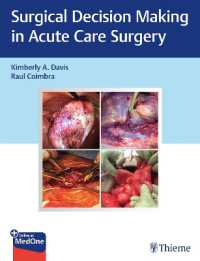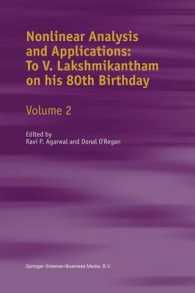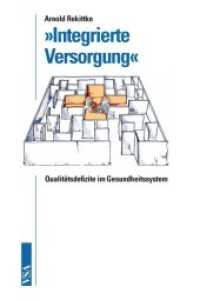- ホーム
- > 洋書
- > 英文書
- > Science / Mathematics
Full Description
This book consists of a collection of lectures prepared for a short course on "Fracture Mechanics Methodology" sponsored by the Advisory Group for Aerospace Research and Development (AGARD), part of the North Atlantic Treaty Organization (NATO). The course was organized jointly by Professor George C. Sih of the Institute of Fracture and Solid Mechanics at Lehigh University in the United States and Professor Luciano Faria from Centro de Mecanica e de Materiais das Universidade de Lisboa in Portugal. It was held in Lisbon from June 1 to 4, 1981. Dr. Robert Badaliance from the McDonnell Aircraft Company in St. Louis and Dr. Oscar Orringer from the Depart- ment of Transportation in Cambridge are the other US lecturers while Professor Carlos Moura Branco from Portugal also lectured. The audience consisted of engineers from the Portuguese industry with a large portion from the aeronautical sector and others who are particularly interested to apply the fracture mechanics discipline for analyzing the integrity of structural components and fracture control methods. Particular. emphases were given to the fundamentals of fracture mechanics as applied to aircraft structures.
Contents
1. Fatigue life prediction: metals and composites.- 1.1. Introduction.- 1.2. Random spectrum load generation.- 1.3. Constant amplitude fatigue.- 1.4. Spectrum fatigue.- References.- 2. Fracture mechanics of engineering structural components.- 2.1. Introduction.- 2.2. Strength and fracture properties of materials.- 2.3. Simple fracture experiments.- 2.4. Design of machine and structural components.- 2.5. Ductile fracture.- 2.6. Fatigue crack propagation.- 2.7. Appendix I. Strain energy density factor in linear elasticity.- 2.8. Appendix II. Critical ligament length.- 2.9. Appendix III. Fracture toughness test.- 2.10. Appendix IV. A brief account of ductile fracture criteria.- References.- 3. Failure mechanics: damage evaluation of structural components.- 3.1. Introduction.- 3.2. Failure of a railroad passenger car wheel.- 3.3. Describing the load environment.- 3.4. Interpreting service load data.- 3.5. Predicting safe life.- 3.6. Maintaining perspective.- 3.7. Concluding remarks.- References.- 4. Critical analysis of flaw acceptance methods.- 4.1. Introduction.- 4.2. Defects: distribution and non-destructive testing capability.- 4.3. Damage tolerance assessment.- 4.4 Flaw acceptance criteria.- 4.5. Conclusions.- References.- 5. Reliability in probabilistic design.- 5.1. Introduction.- 5.2. Structural integrity.- 5.3. Designing for structural integrity.- 5.4. Safety factor and reliability.- References.








